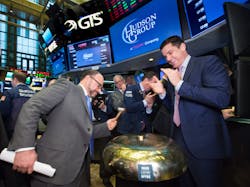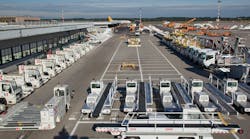A staple of airport retail across North America, Hudson Group is evolving to meet changing needs of travelers. The company made recent announcements about major contracts at several airports.It also announced a new partnership with FAO Schwarz and the company officially went public in February and is now listed on the New York Stock Exchange.
Airport Business recently spoke with Hudson Group President and CEO Joe DiDomizio to talk about the current status of the retailer and what he sees for the future.
Airport Business: There’s a lot of pressure right now on the retail market. Can you talk about some of the pressures you’re seeing as an airport retailer?
Joe DiDomizio: Retail in general might have some pressures relative to how ecommerce is cannibalizing street retailers, but our business is very different than street retail. When you get to an airport, we’re satisfying the immediate needs and wants of travelers. If you’re buying something online in an airport that’s 23 hours too late. We have a captive audience. Average dwell time is around 75 minutes. These customers have a high propensity to spend and we really focus on catering to their immediate needs and wants. Travel is a very stressful thing and when you’re stressed you tend to have certain needs and they tend to be exacerbated by the stress of travel, so as retailers we’re very progressive in this area and we’re really in a good place. We’re not seeing the pressures that the street retailers are.
AB: What kind of role do you see technology playing in the type of retail you’re conducting in an airport?
JD: We’re a brick and mortar retailer. When you’re in an airport, you have certain wants and needs and they need to be satisfied while you’re there. The opportunity we have with the really focused market we serve in airports is a unique one. We really see a long-term opportunity to leverage digital platforms, such as product consulting, payments and individual promotions. This is a way to improve customer service and conversions in our stores and ultimately drive long-term sales growth.
AB: What challenges do you see now as an airport retailer given it’s so different from a street retailer especially given the record numbers of people traveling by air?
JD: I love our business. Travel retail is a growing and very resilient industry. Passenger volumes grew 3 percent annually on average from 2010 to 2016. That’s expected to continue through 2025. Sales at the top 35 airports grew to approximately $8 billion in 2016. That’s a growth of 7 percent annually since 2010. Airports are these very dynamic and constantly evolving places. They’re always looking to grow non-aeronautical revenue. I think this puts us in a very advantageous position relative to traditional retailers and much of our competition. Our merchandising mix is evolving quickly to meet the immediate needs and wants of the travelers. I think the challenge we have is to be proactive by meeting those changing habits because it has happened very quick.
We started in 1987 as a newsstand. Because our approach has been about being the traveler’s best friend, that’s the core purpose of our company. Our management team has been nimble and flexible to adjust as demographics have changed and consumer preferences have changed. We really evolved because it has always been about serving the immediate wants and needs of the traveler. That purpose has served us very well because it’s very flexible.
AB: What are some of the trends travelers want from you? Or what are airports asking of you as a retailer?
JD: The airports aren’t really asking. They’re relying on us because we’re the innovators in product assortment and we’re the ones really on top of all the trends. One of the biggest trends that I see this year are Bluetooth headphones, in particular, the true wireless Bluetooth. That’s a trend we’re seeing today and we’re all over this. I think airports rely on us as a travel retailer that knows customers that operates across 1,000 stores in 80 different travel destinations.
AB: Can you tell me what the new concept with FAO Schwarz is going to look like?
JD: Remember, you have the customer with a high propensity to spend and the 75 minute wait time. That combination of things creates an opportunity to connect with passengers emotionally. It’s about the entertainment and the experience. One of the most important things is to entertain young travelers when they’re traveling. Things for them to do and keep them busy. This provides that opportunity. It also is an opportunity for parents who travel. I travel and I often bring back gifts, so there’s something for me to bring back to my children when I travel. The look and feel is going to be driven around experience.
It’s going to have a lot of plush, it’s going to have a lot of activities and games and fun things so there’s an experience to the shopping environment more than just putting toys on a shelf.
We offer travelers a variety of different shopping opportunities and FAO is the best brand that we could have partnered with in respect to the toy and children’s activity experience in an airport.
AB: With Hudson recently going public, how is this going to help develop your product in airports?
JD: Hudson has been in business for more than 30 years now and this was just the time to share the company with the public markets. Our IPO now gives investors direct ownership of the growing North American business. We have always demonstrated sustained growth and have been amongst the best-in-class brands in the industry. The North American market is very different than the markets around the world.
There are different travel categories and the travel habits are different in North America, so the retail offerings are different. This opportunity gives us both operational and financial flexibility to really execute around the differences between North America and the rest of the world.
AB: What impact do you see the anticipated surge in international traffic from mainland China having the airport retail environment?
JD: Specific to the markets they travel yes, you’re going to see a lot more vacation and duty-free shopping. You’ll see far more dedication to the type of retail the mainland China customers will want to see. Each of the markets we serve those concession programs are crafted around the specific demographics in that market. They may seem similar and have some similarities, but not all of them are the same.
When you look at places like Vancouver and Toronto, yes, you’re going to see us cater to the needs of those travelers because they have such a higher propensity to spend than most passengers do. The vast majority of airports in the nation don’t cater to a lot of foreign nationals like the big markets like Seattle, Los Angeles, San Francisco, New York, Toronto and Vancouver. We tailor the retail program to the specific demographics of the market and that’s how we approach all the markets we serve.
AB: As an airport retailer is there anything now that could pose a potential concern for your business?
JD: With the acceleration of new technology, there will constantly be new innovation and potentially new ways to travel. But from my point of view, we’re in a resilient industry and it’s constantly growing. Every airport has a master plan, they have master plans to expand terminals, to grow new terminals and when you see expanded and new terminals being added they focus on non-aeronautical revenue and serving passengers and airport concessions are a significant part of this. I don’t see anything slowing airports down. Air travel is a way of life, so unless someone figures a way out on how to beam somebody from one market to another, people are going to take to the air. And we’re in a great position to continue to serve this industry.



